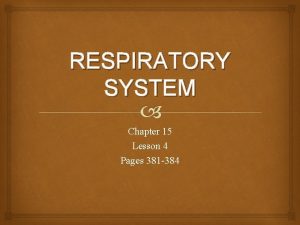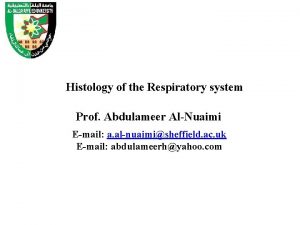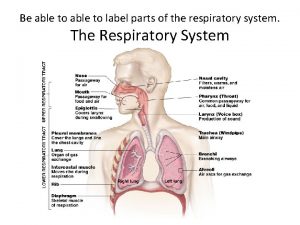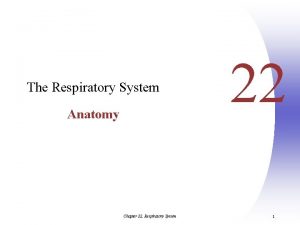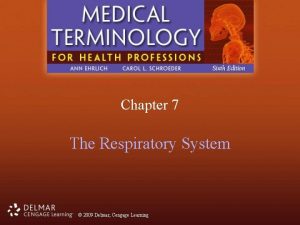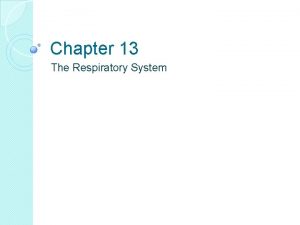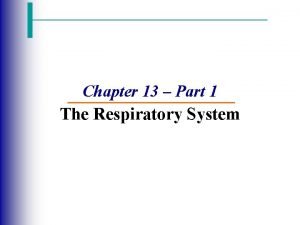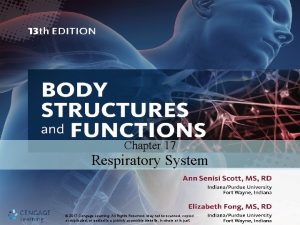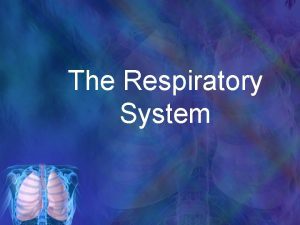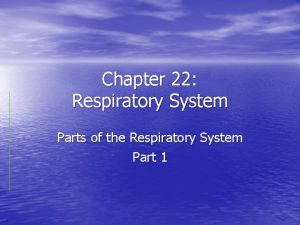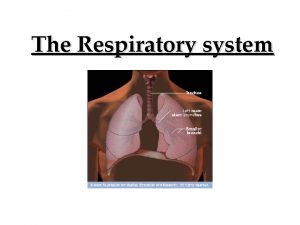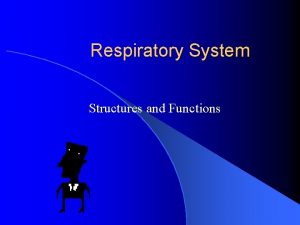Chapter 22 Respiratory System Parts of the Respiratory


















- Slides: 18

Chapter 22: Respiratory System Parts of the Respiratory System

Parts • Nose, pharynx (throat), larynx (voice box), trachea (windpipe), bronchi, and lungs.

Parts of the Respiratory System • Nose & nasal cavity – Only external part of the respiratory system. – Provides an airway for respiration. – Moistens, warms and filters air. – Resonating chamber for speech – Has olfactory (smell) receptors.

Nasal Cavity • Space within internal nose • Cavity is divided by the nasal septum • During breathing air enters the cavity by passing through the nostrils (external nares).

Nasal Conchae • Superior, middle, and • • inferior Protrude medially from the lateral wall in the nasal cavity (like shelves) Greatly increase the surface area and enhance air turbulence gases swirl and turn the heavier particles fall out and become trapped in mucous covering the “shelves”

Paranasal Sinuses • Surround the nasal • • • cavity Located in the frontal, sphenoid, ethmoid, and maxillary bones. “Spaces” in the facial bones Lighten skull Warm and moisten air Produce mucous – flows into the nasal cavity. Blowing your nose helps drain the sinuses

Homeostatic Imbalance • Viruses, streptococcal bacteria, allergens can cause rhinitis inflammation of the nasal mucosa that is accompanied by excessive mucus production, congestion and postnasal drip. • Sinusitis When the passageways to the sinuses are blocked, the air in the cavity is absorbed causing a partial vacuum and a sinus headache

Pharynx • AKA - Throat. • Muscular tube • extending from behind the nasal cavity to the larynx Passageway for food and air, resonating chamber for speech, houses tonsils

Pharynx • Three regions: nasopharynx, oropharynx, laryngopharynx

Larynx • AKA - Voice box • 3 main functions: – Provides an open airway – Acts as a switching mechanism for food and air. – Sound production

Anatomy of Larynx - Epiglottis • Flexible, spoon • • shaped piece of elastic cartilage that covers the larynx when swallowing Keeps everything going down the correct “tube” If anything other than food enters the larynx, the cough reflex is triggered Epiglottis

Glottis • The “hole” seen at the • opening of the larynx. On either side you will see 2 strips of membranous tissue vocal cords (sound production) appear white because lack blood vessels.

Glottis • False vocal cords – above and lateral to the vocal cords. Play no part in sound production but help close the glottis when we swallow

Voice Production • Speech involves the intermittent release of expired air and the opening and closing of the glottis • Sound originates from the vibration of the vocal folds, but other structures are necessary for converting the sound into recognizable speech

Voice Production • Vowel sounds – • • contract/relax muscles in pharynx Enunciate words – muscles of face, tongue, and lips Whispering – vocal folds don’t vibrate changing shape of oral cavity while enunciate produces speech

Voice Production • Loudness depends on the force with which air rushes across the vocal cords. – Greater force stronger vibration louder

Voice Production • During puberty a boy’s larynx enlarges and his true vocal cords become longer and thicker vibrates slower voice becomes deeper (voice “cracks” until he learns to control the larger true vocal cords)

Laryngitis • Inflammation of the • vocal folds interferes with their vibration changes voice tone, hoarseness, or inability to talk. Caused by overuse, dry air, bacterial infection, tumors on vocal folds, inhalation of irritating chemicals
 Conducting zone vs respiratory zone
Conducting zone vs respiratory zone Circularory system
Circularory system The parts of the respiratory system in order
The parts of the respiratory system in order Pharynx histology
Pharynx histology Label parts of the respiratory system
Label parts of the respiratory system How respiratory system work with circulatory system
How respiratory system work with circulatory system Circulatory system and respiratory system work together
Circulatory system and respiratory system work together Pharyngorrhea
Pharyngorrhea Bronchide
Bronchide Respiratory system
Respiratory system Chapter 7 the respiratory system labeling exercises
Chapter 7 the respiratory system labeling exercises Chapter 34 section 2 the respiratory system
Chapter 34 section 2 the respiratory system Respiratory system organs
Respiratory system organs Chapter 13 respiratory system worksheet
Chapter 13 respiratory system worksheet Chapter 17 respiratory system workbook answers
Chapter 17 respiratory system workbook answers Pulmonary tract
Pulmonary tract Hát kết hợp bộ gõ cơ thể
Hát kết hợp bộ gõ cơ thể Bổ thể
Bổ thể


